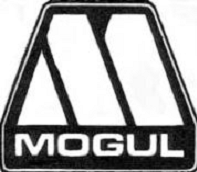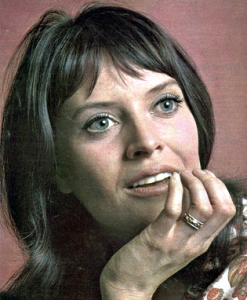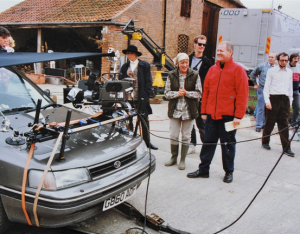Background
07/07/1965-290/9/1965 (“Mogul”); 30/04/1966-03/01/1972 (“Troubleshooters”)
136 x 50 min, black & white/colour
The BBC’s “Mogul”, retitled “The Troubleshooters” after its first season, followed the globe-trotting exploits of Peter Thornton, Australian field agent for Mogul Oil, run by the hard-nosed Brian Stead (almost certainly a play on the word ‘bastard’), played by Geoffrey Keen.
The programme’s title sequence, featuring spurting oil rigs, speedboats and fast cars, and its strident theme (composed by Tom Springfield, brother of Dusty), promised excitement and action, rather than the unhurried 50 minutes of drama that followed. But the production was successful enough to win the rare honour of overseas location filming, as far afield as Africa.
Alec Bray
I worked on the first series of “Mogul” – I think it was in Riverside 1 – and although it had a very good cast, I thought that the programme was turgid to work on.
Alan Stokes
I think I recall being a very junior operator on "The Troubleshooters" which was made in monochrome but in colour studios. I found it a bit odd (probably pre 625 on BBC 1)
John Wardle
I remember doing “Troubleshooters” in TC8, probably sometime 1970 to 1972. It would have been in 625 on the EMI 2001s. I also seem to remember one recording having a lightweight ‘handheld’ camera brought in from OBs. It may have been a Philips PC100.
John Nottage
I remember working on “Troubleshooters” – and an after show party where I was able to chat to the delectable Isobel Black!
Tony Grant
I recall an episode of “Troubleshooters” that had half the studio (TC1, I think) devoted to a night club, with a stage allegedly for strippers. I was on a ped behind the stage, with only one or two shots, and there was a young lady playing the part of the stripper, who waited round the back for her cue to appear. She was wearing a dressing gown, with only a few spangly bits underneath, and you can imagine the wobbly shots I produced after she walked over to me, took off the dressing gown and handed it to me, asking me to hold it whilst she was on stage.
Bernie Newnham
I worked on a “Troubleshooters” directed by Lennie Mayne. There was a big nightclub scene, and Lennie had engaged a suitable performer – a woman painted green wearing only tiny knickers, who did fire-eating. In the afternoon Lennie decided we should all check out her act – purely for lighting etc of course. On the recording she did it all again, but was pretty much unseen on camera.
On location with “The Troubleshooters”.
Bernie Newnham
I see, Albert, that you’re standing next to that cable that Ikegamis had that were designed especially for tripping up directors.
Albert Barber
I remember John Nottage (far right).
Film/Video Hybrid
see http://www.screenonline.org.uk/tv/id/518529/
clip:
“Troubleshooters” was used by the BBC as a test bed for a system that aimed to combine the speed and ease of video recording with the quality of 35mm film. The episode ”You’re Not Going To Believe This But…” (tx. 17/2/1969) was rerecorded using a newly-developed process that mounted a film camera alongside a video camera. Edit marks were automatically added to the film by a remote feed from the vision mixer’s desk, enabling a film editor to exactly match the video version of the show.
Chris Eames
On the subject of the film experiment in R1. I remember working in R2 while it was going on, and going for a chat with some of the crew doing the experiment. I can’t remember who I spoke to, but from a cameraman’s point of view they were a nightmare to operate. The video assist was only a Vidicon so the quality was poor. The system used to get the picture to the tube relied on a mirror somewhere on the film camera shutter, so when the film camera ran, it tended to flicker, and the cameras had large film magazines – so were large and unwieldy – even compared to the usual R1 Pye cameras.
As I said, this is only what I was told – there is probably someone out there who actually used the devices!
Barry Bonner
Regarding hybrid video/film, many moons ago in the late 60s early 70s when we sound guys were short of funds we use to ‘moonlight’ down at Granville studios in Fulham as the Sound Supervisor was an ex BBC colleague. They ran the Gemini video/film system using Marconi Mk.? cameras, same as were then in TC7. Interesting incident happened one day, when the lighting guy turned up, he was a then current BBC TM1……….he was really embarrassed so I promised not to tell anyone thus keeping me safe!
Alasdair Lawrance:
Mention of the Granville is where ILEA’s late Chief Engineer, Walter Kemp, worked. I think the cameras were Marconi IVs. I still wonder about the run-up time for the film cameras – surely they didn’t run all the time? And if they only started when the camera was cut up, wouldn’t the start of the shot be missed?
Barry Bonner
I seem to remember that there was a 2 second or so run-up done by the vision mixer.
Chris Eames
It was explained to me that the cameras were run up using a preview system on the (primitive) vision mixer, thus they would run when the shot before was on air. Don’t know what happened on a fast cutting sequence, or if the director changed his mind! This was the system that I saw in Riverside, not sure if that was Gemini.
Dave Buckley
When I moved to TV Training in 1969, the then production instructor (Philip Thompson), on the first day of what was known as the Combined Production Course, would run a series of films from Andy Stewart going down the Clyde to clips from the “Forsyte Saga”.
He always ended with a clip from this video/film hybrid experiment (shot at Riverside) which was based on an episode of “The Troubleshooters”, and asked the course to comment on the process. The film was 35mm and was always difficult to get hold of as it was virtually under ‘voice lock’ at film library.





